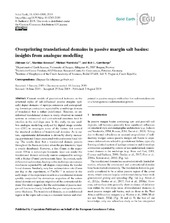| dc.contributor.author | Ge, Zhiyuan | |
| dc.contributor.author | Rosenau, Matthias | |
| dc.contributor.author | Warsitzka, Michael | |
| dc.contributor.author | Gawthorpe, Rob | |
| dc.date.accessioned | 2020-04-21T16:25:19Z | |
| dc.date.available | 2020-04-21T16:25:19Z | |
| dc.date.issued | 2019-08-02 | |
| dc.Published | Ge Z, Rosenau M, Warsitzka, Gawthorpe R L. Overprinting translational domains in passive margin salt basins: insights from analogue modelling. Solid Earth (SE). 2019;10:(4):1283–1300 | eng |
| dc.identifier.issn | 1869-9510 | en_US |
| dc.identifier.issn | 1869-9529 | en_US |
| dc.identifier.uri | https://hdl.handle.net/1956/21960 | |
| dc.description.abstract | Current models of gravitational tectonics on the structural styles of salt-influenced passive margins typically depict domains of upslope extension and corresponding downslope contraction separated by a mid-slope domain of translation that is rather undeformed. However, an undeformed translational domain is rarely observed in natural systems as extensional and contractional structures tend to interfere in the mid-slope area. In this study, we use sandbox analogue modelling analysed by digital image correlation (DIC) to investigate some of the factors that control the structural evolution of translational domains. As in nature, experimental deformation is driven by slowly increasing gravitational forces associated with continuous basal tilting. The results show that a translational domain persists throughout the basin evolution when the pre-kinematic layer is evenly distributed. However, a thin (1 mm in the experiment, 100 m in nature) pre-kinematic layer can render the translational domain relatively narrow compared to settings with a thicker (5 mm) pre-kinematic layer. In contrast, early differential sedimentary loading in the mid-slope area creates minibasins separated by salt diapirs overprinting the translational domain. Similarly, very low sedimentation rate (1 mm per day in the experiment, < 17 m Ma−1 in nature) in the early stage of the experiment results in a translational domain quickly overprinted by downslope migration of the extensional domain and upslope migration of the contractional domain. Our study suggests that the architecture of passive margin salt basins is closely linked to the pre- and syn-kinematic cover thickness. The translational domain, as an undeformed region in the supra-salt cover, is a transient feature and overprinted in passive margins with either low sedimentation rate or a heterogeneous sedimentation pattern. | en_US |
| dc.language.iso | eng | eng |
| dc.publisher | European Geosciences Union | en_US |
| dc.rights | Attribution CC BY | eng |
| dc.rights.uri | http://creativecommons.org/licenses/by/4.0/ | eng |
| dc.title | Overprinting translational domains in passive margin salt basins: insights from analogue modelling | en_US |
| dc.type | Peer reviewed | |
| dc.type | Journal article | |
| dc.date.updated | 2020-01-04T13:50:39Z | |
| dc.description.version | publishedVersion | en_US |
| dc.rights.holder | Copyright 2019. The Authors. | en_US |
| dc.identifier.doi | https://doi.org/10.5194/se-10-1283-2019 | |
| dc.identifier.cristin | 1766256 | |
| dc.source.journal | Solid Earth (SE) | |
| dc.relation.project | Equinor: Equinor | |

